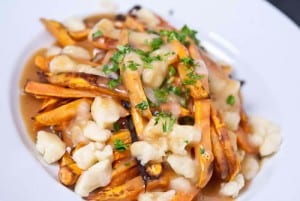 OK, I’ll readily admit that I’ve never actually had a poutine – it’s just that Canada is the home of this very popular national dish – one that’s almost the Canuck equivalent to “American as Apple pie”. According to what I could find about its origins, poutine is a made-up French Canadian slang word, and loosely translates to . . . are you ready for this? . . . “mushy mess”. It’s also known as a “heart attack in a bowl”. So far, does this sound like you’d rush out to order a couple? OK, if you really want to know more about a poutine, go here http://members.shaw.ca/kcic1/poutine.html, and if you want to try one for yourself, there’s a sweet potato recipe here http://norecipes.com/sweet-potato-poutine-recipe/. (Incidentally, those white thingees in the photo are cheese curds, and the Canucks are very finicky about where they source their curds.)
OK, I’ll readily admit that I’ve never actually had a poutine – it’s just that Canada is the home of this very popular national dish – one that’s almost the Canuck equivalent to “American as Apple pie”. According to what I could find about its origins, poutine is a made-up French Canadian slang word, and loosely translates to . . . are you ready for this? . . . “mushy mess”. It’s also known as a “heart attack in a bowl”. So far, does this sound like you’d rush out to order a couple? OK, if you really want to know more about a poutine, go here http://members.shaw.ca/kcic1/poutine.html, and if you want to try one for yourself, there’s a sweet potato recipe here http://norecipes.com/sweet-potato-poutine-recipe/. (Incidentally, those white thingees in the photo are cheese curds, and the Canucks are very finicky about where they source their curds.)
In any case, it’s now a bit over two weeks since we departed Anacortes and we’re lying at a Seattle Yacht Club outstation – Garden Bay in Pender Harbour. After departing Delta Marine a couple of days ago, we spent the first night at the SYC outstation on Ovens Island. Delta Marine is a Fleming service yard tucked deep into Tsehum Harbour on the north side of Sidney, B.C. After a year and a half of disuse, we soon found Flying Colours to be in need of more TLC than she’d been getting up to that time. We just spent three days in the Delta Marine yard, including a “half haul-out” one afternoon to pressure wash the boat’s bottom to rid it of whatever’s growing there – and to hopefully find out what was causing slow speeds, lowered RPM, and increased fuel usage during cruise. As the stay went on, the list of additional (and necessary) things increased – but that’s all part of owning a boat.
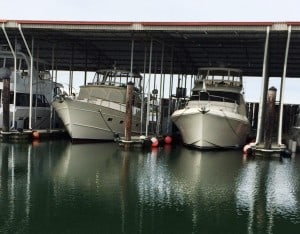 How Did We Get To This Point? Looking back at Summer, 2013, it’s hard to believe we didn’t spend even a single day aboard Flying Colours. Our cruising friends would say that’s almost a criminal offense, except that we had some good excuses. In the early Spring 2013, Kap led things off with some pretty major surgery – with a full recovery that was expected to be 4 weeks or so, but turned out to be several weeks longer. We then moved into our new house the first week of July, and as you can imagine this required lots of pre-move work, packing and planning, followed by even more post-move work getting settled in (and even a year later, we still have rooms that are crammed full of boxes and stuff that needs to be unpacked). Then just to make life really interesting, I had two partial knee replacement surgeries – on the left knee in mid-August, followed by the right knee in late-September – both were very successful, and the recovery was much easier and quicker than expected. So, I guess our excuses justified a totally blank Flying Colours blog for 2013.
How Did We Get To This Point? Looking back at Summer, 2013, it’s hard to believe we didn’t spend even a single day aboard Flying Colours. Our cruising friends would say that’s almost a criminal offense, except that we had some good excuses. In the early Spring 2013, Kap led things off with some pretty major surgery – with a full recovery that was expected to be 4 weeks or so, but turned out to be several weeks longer. We then moved into our new house the first week of July, and as you can imagine this required lots of pre-move work, packing and planning, followed by even more post-move work getting settled in (and even a year later, we still have rooms that are crammed full of boxes and stuff that needs to be unpacked). Then just to make life really interesting, I had two partial knee replacement surgeries – on the left knee in mid-August, followed by the right knee in late-September – both were very successful, and the recovery was much easier and quicker than expected. So, I guess our excuses justified a totally blank Flying Colours blog for 2013.
(Remember, you can click on any photo to enlarge. Also don’t forget that the formatting of this blog entry is better – and the captions line up with the photos – when you can read it online at www.ronf-flyingcolours.com – click on this link to go there. Also, if you’re logged into the post with your own userid, you can request an automatic update whenever a new blog post is put up – just click on the Subscribe link and give it your e-mail address. You cannot do this, though, if you’re logged in using the “friends” username.)
Getting Ready For The 2014 Cruising Season. It was around mid-May when we began our twice-a-week trips to Anacortes getting Flying Colours ready for the 2014 cruising season. First up, we decided it was time to do a good housecleaning on the boat. Cruising every year since 2009, there was lots of stuff that we never used or was out of date, and it just accumulated.
Leaving a cruising trawler like Flying Colours idle for a year and a half has its downside – not least of it is the increased challenge getting it ready for this cruising season. Maintenance that’s been delayed for a year is now more than normal, and foregone winter projects have stacked up. Lots of things on board have expiration dates, and that means two years’ worth to resolve. Pantry supplies have gone past their sell by dates, and not only does a lot of it have to be thrown out, but also replaced with fresh goods. Fresh water holding tanks are no longer as fresh as we’d like them; black water tanks have likely sludged up. And, of course, Kap picks this year to give the entire boat a good “going over”, sorting through every drawer and storage area where five years of accumulated “stuff” (that we thought we might need, but didn’t) gets thrown out or hauled to our storage shed at the top of the dock. All the while, the arthritis in Kap’s lower back is flaring up, making it impossible to work more than one day at a time before she retreats to the heating pad for comfort. It’s going to take the proverbial month of Sundays to get Flying Colours ready to go.
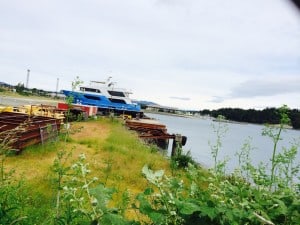
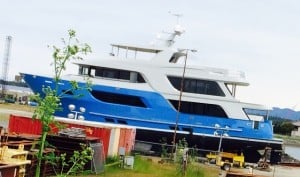 But Wait – Let’s First Witness A New Yacht Launch That Seriously Goes Wrong! Late on a Sunday afternoon in mid-May, shortly after Kap and I left the marina and headed for home, there was an attempted launch of an 85′ custom yacht that just completed build in Anacortes. The first thing next morning we spotted a local news item that it had capsized during launch. Within a day or so a video of the launch popped up on YouTube (https://www.youtube.com/watch?v=lEBJjsdTyWY) and it’s pretty amazing. Supposedly the owner who commissioned the build had sunk somewhere between $10-15M into it. It was built for a serious circumnavigation (i.e., round the world cruise), and was a no-holds-barred design and outfitting (normally, 85’ yachts don’t cost anywhere near that amount). Supposedly (according to some rumor and innuendo found on the internet, there were known stability issues with the boat, but they were to have been addressed after launch with more ballast – which seems odd, given that the boat listed to port immediately upon entering the water and then rolled onto the port side on the large rocks next to the ramp. What a disaster!
But Wait – Let’s First Witness A New Yacht Launch That Seriously Goes Wrong! Late on a Sunday afternoon in mid-May, shortly after Kap and I left the marina and headed for home, there was an attempted launch of an 85′ custom yacht that just completed build in Anacortes. The first thing next morning we spotted a local news item that it had capsized during launch. Within a day or so a video of the launch popped up on YouTube (https://www.youtube.com/watch?v=lEBJjsdTyWY) and it’s pretty amazing. Supposedly the owner who commissioned the build had sunk somewhere between $10-15M into it. It was built for a serious circumnavigation (i.e., round the world cruise), and was a no-holds-barred design and outfitting (normally, 85’ yachts don’t cost anywhere near that amount). Supposedly (according to some rumor and innuendo found on the internet, there were known stability issues with the boat, but they were to have been addressed after launch with more ballast – which seems odd, given that the boat listed to port immediately upon entering the water and then rolled onto the port side on the large rocks next to the ramp. What a disaster!
Back To Getting Ready. After several weeks of work, we initially set our departure date for June 4th, based on a cruising plan that’s been evolving (I should say, drawn, scrapped, redrawn, scrapped, redrawn, a half dozen times). With our freezer completely empty of B.C. spotted prawns, the top priority is set for heading to the top end of Vancouver Island and into the Broughton’s where we have a favorite prawning spot. Before we head north, though, we hope to meet up with our friends, Steve and Andrea Clark on Couverden for a long weekend at Victoria Harbour, where the Lopez Island Yacht Club are having a rendezvous (as well as the usual birthday party for Steve). This year’s get-together is at the marina directly in front of the Empress Hotel.
After hopefully filling an iced cooler with two fishing license quotas of the little critters, we’ll then fly home sometime in July to get them in the freezer, leaving Flying Colours parked somewhere north. We’ll then return (hopefully after getting one or two dangling projects on the house wrapped up, and we’re thinking we’ll head further north along the Inside Passage this time, where Kap wants to visit (at that point, we’re about 375 miles north of Anacortes, and 450 miles north of Seattle).
Located far up the Cousins Inlet, Ocean Falls is a veritable ghost town, with a winter population of 25, and it shoots up to 100 in summer. Known as the Home of the Rain People – and whether it’s because it rains a lot there, or just as likely, based on an ancient First Nations People legend is something we’ll have to find out if we visit.
But I’m getting way ahead of myself – we haven’t even left the dock at Anacortes yet, and we’re still getting Flying Colours ready to go.
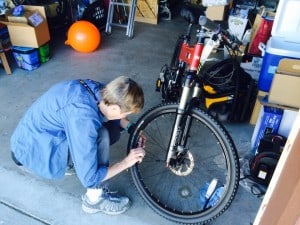
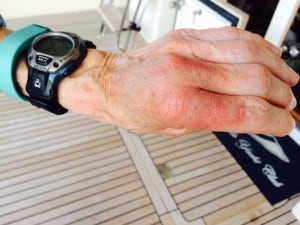 Cap’n Crunch. For four or five years now, Kap has had a knack for breaking or injuring some part of her body the day before a trip (a wrist, a leg bone, two bones in her foot, etc). Just to show she hasn’t lost her touch, she did it again this year, but not as serious as previous incidents. While pumping up the tires on our folding bicycles before loading them onto Flying Colours, her hand slipped as she was wrestling with a stuck inner tube valve. When it finally gave way, the back of her hand hit hard against a nearby spoke, breaking a blood vessel and not only causing two knuckles to swell but also blackened about 2/3rds of her hand. I guess it looked worse than it felt, but it was another indication that we need to get her a body-sized bubble suit to wear for several days before we depart each year.
Cap’n Crunch. For four or five years now, Kap has had a knack for breaking or injuring some part of her body the day before a trip (a wrist, a leg bone, two bones in her foot, etc). Just to show she hasn’t lost her touch, she did it again this year, but not as serious as previous incidents. While pumping up the tires on our folding bicycles before loading them onto Flying Colours, her hand slipped as she was wrestling with a stuck inner tube valve. When it finally gave way, the back of her hand hit hard against a nearby spoke, breaking a blood vessel and not only causing two knuckles to swell but also blackened about 2/3rds of her hand. I guess it looked worse than it felt, but it was another indication that we need to get her a body-sized bubble suit to wear for several days before we depart each year.
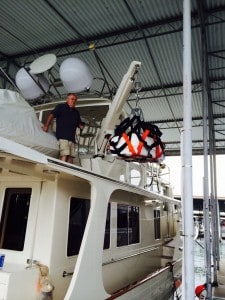
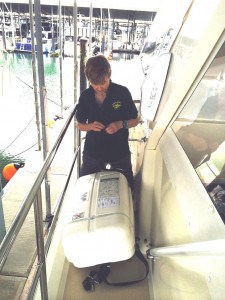
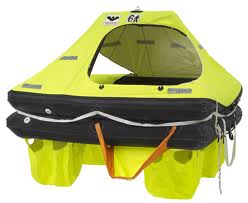 We bought a really neat toy this spring for loading heavy things aboard Flying Colours – a 4′ square, military-grade, webbing-style cargo net – with a rated lifting capacity of 2,500 lbs (more than we’ll ever need). It’s perfect for winching the monstrously heavy emergency life raft aboard – and we were convinced of this after manhandling this devilishly awkward fiberglass container, with no way to get a hand grip on it. The life raft ran out of its certification after five years aboard Flying Colours and needed a re-packing by the manufacturer in South Seattle (otherwise, the Coast Guard will raise hell if they board us and find it’s out of certified pack date). The life raft is a Viking RescYou 6-person coastal liferaft, and it’s really hard to believe that the thing you see in the photo actually fits into the hard-sided case.
We bought a really neat toy this spring for loading heavy things aboard Flying Colours – a 4′ square, military-grade, webbing-style cargo net – with a rated lifting capacity of 2,500 lbs (more than we’ll ever need). It’s perfect for winching the monstrously heavy emergency life raft aboard – and we were convinced of this after manhandling this devilishly awkward fiberglass container, with no way to get a hand grip on it. The life raft ran out of its certification after five years aboard Flying Colours and needed a re-packing by the manufacturer in South Seattle (otherwise, the Coast Guard will raise hell if they board us and find it’s out of certified pack date). The life raft is a Viking RescYou 6-person coastal liferaft, and it’s really hard to believe that the thing you see in the photo actually fits into the hard-sided case.
The way it works is, a strap around the case is fastened to the mounting frame on the upper dinghy deck. There’s a complicated release mechanism that jettisons this strap when water activates it (i.e., Flying Colours is sinking, and sea water has reached this deck, and after the container is free of the boat (but still connected by a life line so that we can jump in), an explosive CO2 cartridge pops the life raft out and inflates it. It has all kinds of survival gear in it, plus multiple rescuer signaling devices. In case you’re wondering, the four thingees hanging down below act like sea anchors for stability – they’re simply nylon pockets that hold a couple of gallons of sea water as you’re bobbing along, and the drag from that keeps the liferaft from rocking and rolling too much. It’s pretty ingenious, but I sure hope we never get to use it for real.
What a difference it made, though, having the cargo net to lift the liferaft onto the upper deck and into place when it returned to the boat!
As another example of things that can go wrong when you don’t use it often enough, we decided to drain the fresh water tank of the one and a half year-old stale fresh water in it and refill it with fresh. The night before, Kap put some bleach (chlorine) in it to kill the nasties. The next morning she opened the galley sink tap to drain the 300 gallon tank. I didn’t know it, but to get it to drain more quickly, she also opened the taps in the master and guest heads. Soon after, as she was walking past the guest head, Kap let out a yell (I won’t elaborate on the specific words). The shower pan in the guest head was overflowing and water from it was running onto the floor and into the companionway. For reasons that are too complicated to go into here, the guest head sink drains into the sump beneath the shower pan. The shower drain pump has to be turned on to drain it overboard – and the pump had not been turned on. Luckily, Kap just happened to be walking by at the most critical moment, noticed it, and caught the snafu before it created too much water damage.
Finally Getting Outta’ Dodge! After several delays, Monday, June 9, was finally our departure day. Everything possible that we’d need for the summer was loaded aboard and stowed, Flying Colours was somewhat ship-shape – exterior washed and interior cleaned – and we felt ready to go. Around 9AM Kap started up the engines as I readied the lines to drive forward out of our slip (Flying Colours had been stern-in to our slip since Fall, 2012 as that’s the best way to weather the winter winds at our marina). The moment Kap put engines in gear, it was obvious something wasn’t right – strong vibrations rattled through the boat, and the shudder told her to shift immediately to neutral. While I stood at the stern, Kap tried it again and, without a doubt, I could tell we had a problem with the propellers or drive shafts, and most likely outside of the boat. After shutting the engines down, we called Costica – our local maintenance guy in Anacortes and he said he could be there in about an hour. We then called Mike Radding (our Fleming technical guy in Newport Beach, CA) and he gave us a few things to look for. When Costica arrived around noon, we again restarted the engines, and with Flying Colours firmly tied to the dock, Kap engaged the forward gears – this time the vibration was less than before, and seemed to be mainly with the port engine/propeller.
We called for our local diver (a guy named Jim, who is based right in the parking lot of our marina) to take a look at the propellers and shafts. As Jim was getting ready to jump into the water, he mentioned that we were currently having a serious algae bloom, and based on what he’d seen on other boats in the marina, he wondered aloud if we had a mass of algae below the surface and surrounding the props. A light bulb went off – that would explain why the water on the other side of our dock had turned very murky shortly after we first started the engines earlier that morning. Jim went below the surface, checked around the entire hull, and when he surfaced he indicated everything looked good. Concluding that the algae bloom was the likely culprit, we decided to take Flying Colours out for a quick test drive to see if the vibration problem went away. Sure enough, they were significantly lessened (but not entirely), so we decided to depart for Sidney. Assuming we got there OK, we’d have the facilities of Delta Marine, a Fleming maintenance yard that does most of our annual maintenance work. We pulled out of the slip and were away for the Summer Cruise of 2014.
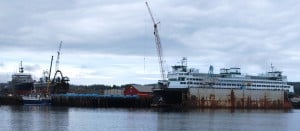 The R/V Sally Ride. On one of our work trips we rove to lunch in downtown Anacortes and noticed a large ship under construction in the drydock at the north end of town and at the foot of the main street, Commercial Avenue. To our surprise, the name on the stern was R/V Sally Ride. Later, on our cruise departure as we passed through the Guemes Channel, we could see the bow of the R/V Sally Ride (it’s at the far left in the accompanying photo, with a Washington State Ferry in drydock being worked on – unfortunately, the photo came out very dark).
The R/V Sally Ride. On one of our work trips we rove to lunch in downtown Anacortes and noticed a large ship under construction in the drydock at the north end of town and at the foot of the main street, Commercial Avenue. To our surprise, the name on the stern was R/V Sally Ride. Later, on our cruise departure as we passed through the Guemes Channel, we could see the bow of the R/V Sally Ride (it’s at the far left in the accompanying photo, with a Washington State Ferry in drydock being worked on – unfortunately, the photo came out very dark).
For readers who aren’t interested in U.S. space travel and didn’t keep up with various Space Shuttle pilots, Sally Ride was the first woman astronaut and the youngest person in space, flying on two missions, the first in 1983 and the second in 1984. She later worked for NASA at a desk job, and also led the investigation into the Challenger disaster. She was also a university professor, a scientist, and “an innovator at Scripps Institution of Oceanography at the University of California, San Diego”. Sadly, Sally Ride died in 2012 at the young age of 61.
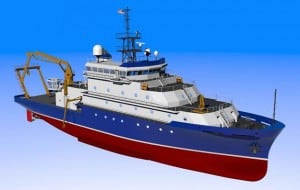 The R/V Sally Ride is the first academic research ship to be named in honor of a woman (R/V stands for research vehicle). At the naming ceremony, Secretary of the Navy Ray Mabus said, “Sally Ride’s career was one of firsts and will inspire generations to come. I named the R/V Sally Ride to honor a great researcher, but also to encourage generations of students to continue exploring, discovering and reaching for the stars.”
The R/V Sally Ride is the first academic research ship to be named in honor of a woman (R/V stands for research vehicle). At the naming ceremony, Secretary of the Navy Ray Mabus said, “Sally Ride’s career was one of firsts and will inspire generations to come. I named the R/V Sally Ride to honor a great researcher, but also to encourage generations of students to continue exploring, discovering and reaching for the stars.”
Built by Dakota Creek Industries, Inc. in Anacortes, the ship is 238’ in length, a beam of 50’, and can operate at more than 12 knots.
Crossing The International Border Into Canada. As we cruised west and headed for Sidney, our GPS indicated shortly after 2PM that we’d crossed the U.S./Canada border. After getting my paperwork in order (and my thoughts arranged for answering questions), I called the 800 number to clear Canada Customs using our Nexus cards. This is usually a smooth, straightforward process, where the Canadian Customs agent (located somewhere, maybe in Vancouver, maybe in Toronto) is very professional, and presumably with our longtime history in their database of crossing the border without incident, they simply ask a couple of perfunctory questions, tell me everything is in order, and give me the 11-digit “clearance number” that I key into a Word document and print out for posting in the salon window in case we’re boarded during the summer.
This time, though, I must have gotten a rookie, as he kept me on the line for at least 15 minutes, asking very detailed questions, first about exactly how much alcohol we had on board. He wasn’t satisfied with my initial answer of “oh, about a half dozen partially filled bottles of spirits”, and wanted to know exactly how many bottles, and exactly how many liters it all added up to. And when I told him 9 bottles, for a total of 5.3 liters, he was satisfied. Since he only asked how much spirits we had on board, I ignored the fact that we had four leftover bottles of really good wine from our last cruising season – I learned long ago that you answer exactly what they ask you, and nothing more. At that he was finally satisfied.
He asked if we had any firearms, as that’s a complete non-starter. If you have any firearms or deadly weapons aboard (including mace and pepper spray), you’ll certainly be asked to report to the nearest Customs dock for further searching, and you very well may not be allowed into Canada. He asked about plants, fruits, and vegetables (again, no). Another question was “how long will you be in Canada”, which was a difficult one to answer, as Flying Colours will be in Canada until mid-October, but Kap and I personally will be returning twice between now and mid-October, and I wasn’t sure whether he was asking about us or the boat – he was asking about us, but it took a while to get that straightened out.
The final question was, “what’s your first port of entry into Canada, and what time will you arrive there?” The significance of this is, with Nexus they could decide to meet you at the dock on arrival and board the boat for inspection, so again, they want to know your expected arrival time within five minutes. With the extended conversation I’d been having with this guy, Kap had slowed way down on her speed, and our planned arrival time of 2:30PM was now out the window. She had to quickly pull up a new ETA from our navigation software. As it turned out (and like every time in the past), they didn’t meet us at the dock – it’s just that they want you to know there’s always the possibility, and if you’ve lied on anything, they yank your Nexus card and won’t re-issue to you for 10 years. It’s one part of the cruise that always feel good once it’s over, knowing that you won’t have to face it again until re-entry to the U.S.
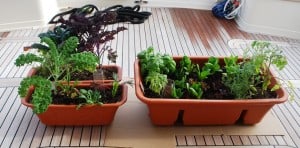 Provisioning In Sidney. Sidney is a nice little town that few have heard of. It’s sort of in the shadow of Victoria, since it’s the home of the Victoria International Airport, and located just 14 miles north on the Saanich Peninsula (at the SE tip of Vancouver Island). With a total population of just under 12,000, with easy access to Victoria by car, there are all of the amenities a boater heading north could ever want – the Port Sidney Marina at the foot of the town’s main street (plus at least a half dozen more scattered around in nearby bays), two really good grocery stores, a dozen good restaurants, good hardware and marine stores, and a popular Thursday night street fair.
Provisioning In Sidney. Sidney is a nice little town that few have heard of. It’s sort of in the shadow of Victoria, since it’s the home of the Victoria International Airport, and located just 14 miles north on the Saanich Peninsula (at the SE tip of Vancouver Island). With a total population of just under 12,000, with easy access to Victoria by car, there are all of the amenities a boater heading north could ever want – the Port Sidney Marina at the foot of the town’s main street (plus at least a half dozen more scattered around in nearby bays), two really good grocery stores, a dozen good restaurants, good hardware and marine stores, and a popular Thursday night street fair.
For the first time, we’ve decided to try our hand at gardening on board Flying Colours, with three pots that we’ve loaded up with several herbs that we use a lot (basil, cilantro, thyme, tarragon), plenty of kale of various kinds, several types of lettuce, and two cherry tomato plants. The stumbling block before has been inability to keep them watered if we left the boat somewhere while we returned home for a week or two – but these molded plastic pots have a water reservoir in the bottom that holds enough water to self-water them for up to two weeks. We’ll see how it goes this summer, and if it’s a success, we could be in fresh greens whenever we want them.
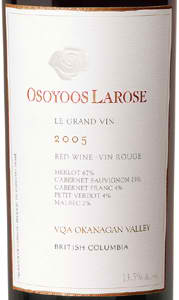 One important provisioning chore in Sidney each year is to fill our wine and spirits cellar. Our favorite wine and liquor store, called The Local, is in the small town of Ganges, on Salt Spring Island. We came upon it quite by accident on our very first shakedown cruise on Cosmo Place, our 42’ Nordic Tug back in 2007. They stock (and have access to) some of the best B.C. wines – wines that have a restricted distribution, and cannot be found anywhere else – and it’s sort of been our policy that we try to drink only B.C. wines during our cruising in B.C. waters. Over the years we’ve gotten to know the owners of The Local, Steve and Colleen Knight, and each spring after we’ve determined how long our summer cruise will be, I send an e-mail to them with our order – specifying how many bottles and which wines we’d like (that is, if they can get them). This year I only ordered two cases of wine (because Kap has been cutting way back on her wine consumption, so it leaves me almost alone to drink it up). One favorite is Osoyoos Larose, a red blend from grapes grown in the Okanogan Valley, but with imported winemaking skills from Château Gruaud Larose in the Bordeaux region of France.
One important provisioning chore in Sidney each year is to fill our wine and spirits cellar. Our favorite wine and liquor store, called The Local, is in the small town of Ganges, on Salt Spring Island. We came upon it quite by accident on our very first shakedown cruise on Cosmo Place, our 42’ Nordic Tug back in 2007. They stock (and have access to) some of the best B.C. wines – wines that have a restricted distribution, and cannot be found anywhere else – and it’s sort of been our policy that we try to drink only B.C. wines during our cruising in B.C. waters. Over the years we’ve gotten to know the owners of The Local, Steve and Colleen Knight, and each spring after we’ve determined how long our summer cruise will be, I send an e-mail to them with our order – specifying how many bottles and which wines we’d like (that is, if they can get them). This year I only ordered two cases of wine (because Kap has been cutting way back on her wine consumption, so it leaves me almost alone to drink it up). One favorite is Osoyoos Larose, a red blend from grapes grown in the Okanogan Valley, but with imported winemaking skills from Château Gruaud Larose in the Bordeaux region of France.
Another favorite is Oculus, a red blend from Mission Hill Winery, again with a vineyard in the Okanogan Valley, but this time in the Kelowna area. Oculus is another Bordeaux-style red wine – made from Merlot, Cabernet Sauvignon, and Cabernet Franc.
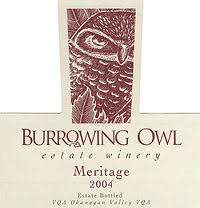 Our overall favorite, though, is Burrowing Owl Meritage, still another red blend of Merlot, Cabernet Sauvignon, Cabernet Franc, Malbec, and Petit Verdot. This wine is the most difficult to get, and I usually take every bottle in stock at The Local – and at season’s end we take any remaining home for our cellar.
Our overall favorite, though, is Burrowing Owl Meritage, still another red blend of Merlot, Cabernet Sauvignon, Cabernet Franc, Malbec, and Petit Verdot. This wine is the most difficult to get, and I usually take every bottle in stock at The Local – and at season’s end we take any remaining home for our cellar.
Not surprisingly, these B.C. wines don’t receive very much attention in the U.S., and are virtually impossible to find even in Washington State – protectionism from the competition they’d give to our West Coast wines, I guess.
The past 2-3 years we’ve bypassed going into Ganges with Flying Colours (it’s considerably out of our way), and I’ve opted to rent a car to pick up the wine. The best part of it is, there’s a B.C. ferry from the terminal on the north side of Sidney that goes to Fulford Sound on the south tip of Salt Spring Island – and from there it’s a 15 minute drive to Ganges. I pop over on the 7AM ferry and return on the 11:50AM ferry, and I get an additional two times to have water under my bum – and on a scenic route at that.
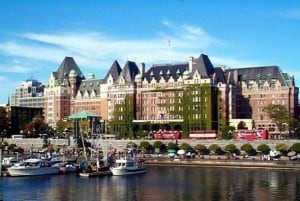
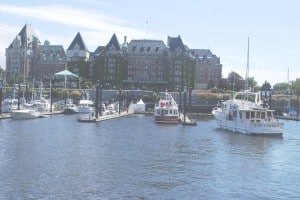 Party Crashing in Victoria, B.C. Before we departed Anacortes, Steve and Andrea Clark aboard Fleming 55, Couverden, invited us to join them at the Lopez Island Yacht Club (LIYC) rendezvous in Victoria Harbour on the weekend of June 13-15th. We never pass up a chance to visit Victoria, so we readily accepted. It was Father’s Day weekend, and the marinas in Victoria had a special moorage fee at the Inner Harbour Marina of only $35/night (at $1.10/foot, and our overall length of 62’, the normal charge would be $68/night, so it really was a special rate).
Party Crashing in Victoria, B.C. Before we departed Anacortes, Steve and Andrea Clark aboard Fleming 55, Couverden, invited us to join them at the Lopez Island Yacht Club (LIYC) rendezvous in Victoria Harbour on the weekend of June 13-15th. We never pass up a chance to visit Victoria, so we readily accepted. It was Father’s Day weekend, and the marinas in Victoria had a special moorage fee at the Inner Harbour Marina of only $35/night (at $1.10/foot, and our overall length of 62’, the normal charge would be $68/night, so it really was a special rate). 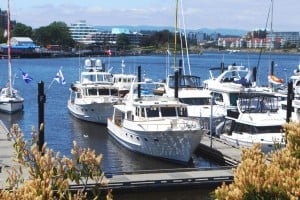 Making it even more special, all 20 of the LIYC boats were given moorage at the Inner Harbour marina, directly in front of the grand Empress Hotel. Couverden and Flying Colours are on the dock at left, with Flying Colours behind Couverden.
Making it even more special, all 20 of the LIYC boats were given moorage at the Inner Harbour marina, directly in front of the grand Empress Hotel. Couverden and Flying Colours are on the dock at left, with Flying Colours behind Couverden.
The beautiful old Empress Hotel was built in 1908 for Canadian Pacific Hotels as a terminus for their steamship line. Canadian Pacific Hotels was a division of Canadian Pacific Railway (CPR), who built a series of wonderful old destination hotels across Canada – such as the one at Banff Springs in Alberta.
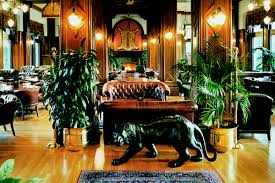 On Saturday, Kap and I joined Steve and Andrea for lunch at the posh Bengal Lounge, located in a rear wing of the Empress Hotel on the ground floor. It’s a wonderful old British Empire-style bar and lounge, decorated in British Colonial décor, with button-tufted lounge chairs, and lots of woods and polished brass. The daily lunch special is a curry buffet, with Tandoori Chicken, Butter Chicken, and several other really good Indian dishes. The Lounge was a favorite haunt of Andrea’s parents, who lived in Port Angeles directly across the Strait of Juan de Fuca from Victoria, and made it a point of having lunch here on their way north each year with their boat. It’s a tradition I could certainly get used to.
On Saturday, Kap and I joined Steve and Andrea for lunch at the posh Bengal Lounge, located in a rear wing of the Empress Hotel on the ground floor. It’s a wonderful old British Empire-style bar and lounge, decorated in British Colonial décor, with button-tufted lounge chairs, and lots of woods and polished brass. The daily lunch special is a curry buffet, with Tandoori Chicken, Butter Chicken, and several other really good Indian dishes. The Lounge was a favorite haunt of Andrea’s parents, who lived in Port Angeles directly across the Strait of Juan de Fuca from Victoria, and made it a point of having lunch here on their way north each year with their boat. It’s a tradition I could certainly get used to.
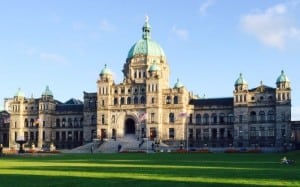
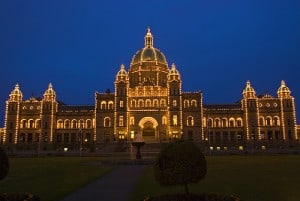 Victoria’s Inner Harbour is easily one of the world’s gems for attracting tourists – even more so than Sydney, Australia – not only for the Empress Hotel, but at 90° from the hotel is the majestic B. C. government Parliament Building (two photos at left), constructed of quarried stone that’s impressive in the daytime, but equally impressive with the nighttime lights turned on. As a result, day and night there are thousands of tourists walking the Promenade, snapping photos, and watching the street buskers (street performers, many of whom are very good). Both of these photos were taken aboard Flying Colours, moored at the Causeway Marina in the Inner Harbour.
Victoria’s Inner Harbour is easily one of the world’s gems for attracting tourists – even more so than Sydney, Australia – not only for the Empress Hotel, but at 90° from the hotel is the majestic B. C. government Parliament Building (two photos at left), constructed of quarried stone that’s impressive in the daytime, but equally impressive with the nighttime lights turned on. As a result, day and night there are thousands of tourists walking the Promenade, snapping photos, and watching the street buskers (street performers, many of whom are very good). Both of these photos were taken aboard Flying Colours, moored at the Causeway Marina in the Inner Harbour.
Andrea’s mother still lives in Port Angeles (the locals just call it PA), and during the summer she returns at least twice to see her aging mother and check in on her caregivers. We’re often cruising with Couverden somewhere on the Inside Passage along the east side of Vancouver Island, and after getting down to Victoria, Andrea takes the Black Ball Line ferry, the MV Coho, across to PA. The Coho is a foot passenger and car/truck ferry that makes four daily runs across the Strait of Juan de Fuca between PA and Victoria, carrying up to 1,000 passengers and 110 vehicles. It’s 341’ long, with a beam of 34’, and has been in service since 1959 (55 years now, and she has some scars to show for it).
Each arrival and departure of the M/V Coho was a close-up event from the cockpit of Flying Colours, as the ferry dock is located just 200’ or so off our stern. The blast from her horn to announce passenger and car loading was so loud it created a vibration inside our salon. The accompanying photo was taken from the cockpit of Flying Colours.
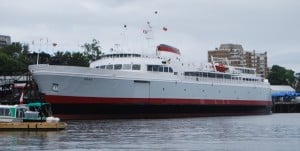 The Black Ball Line has an interesting history – founded in England in 1816 by Captain Charles H. Marshall, and flying a flag with a black ball on a red background. The Black Ball Line operated a fleet of clipper sailing ships (and later steamships) to carry passengers between Liverpool and New York. In 1928, a great-grandson, Captain Alexander Marshall Peabody founded the Puget Sound Navigation Company to operate ferries on Puget Sound under the trade name Black Ball Line. It became the largest privately-owned ferry system in the U.S., with rights to the Seattle-Victoria route, and operating ferries from Seattle, Port Angeles, and Victoria (B.C.). In 1951, when the current M/V Coho was commissioned for the route, the Black Ball Line was owned by a Canadian couple, R.J. and Lois Acheson, but at their death was left to the Oregon State University Foundation, who ran it until it was sold to the company’s management team in 2012.
The Black Ball Line has an interesting history – founded in England in 1816 by Captain Charles H. Marshall, and flying a flag with a black ball on a red background. The Black Ball Line operated a fleet of clipper sailing ships (and later steamships) to carry passengers between Liverpool and New York. In 1928, a great-grandson, Captain Alexander Marshall Peabody founded the Puget Sound Navigation Company to operate ferries on Puget Sound under the trade name Black Ball Line. It became the largest privately-owned ferry system in the U.S., with rights to the Seattle-Victoria route, and operating ferries from Seattle, Port Angeles, and Victoria (B.C.). In 1951, when the current M/V Coho was commissioned for the route, the Black Ball Line was owned by a Canadian couple, R.J. and Lois Acheson, but at their death was left to the Oregon State University Foundation, who ran it until it was sold to the company’s management team in 2012.
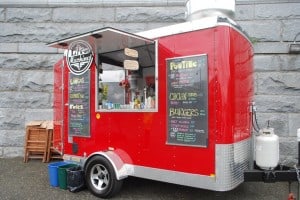
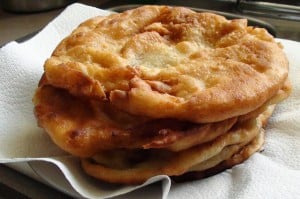 On several recent trips to Victoria, Kap and I like this longtime food cart at Victoria Harbour. It’s called the “Eat Machine”, and they’ve been at the same spot on the harbor promenade for several years now. Their specialty is lángos, a Hungarian potato flat bread that’s eaten as a finger food. We like to rub the top surface with a hunk of garlic to add flavor. In the old country, lángos (which comes from the Hungarian word for flame) was baked in a brick oven, but it’s typically deep fried nowadays. Back in the 1980s when we were spending a huge amount of time on business trips to San Francisco, one of our favorite eating places was a Hungarian restaurant called Paprikas Fono in Ghiradelli Square, and we always had a lángos to start the meal. As a result, we’ll walk the proverbial mile for a lángos.
On several recent trips to Victoria, Kap and I like this longtime food cart at Victoria Harbour. It’s called the “Eat Machine”, and they’ve been at the same spot on the harbor promenade for several years now. Their specialty is lángos, a Hungarian potato flat bread that’s eaten as a finger food. We like to rub the top surface with a hunk of garlic to add flavor. In the old country, lángos (which comes from the Hungarian word for flame) was baked in a brick oven, but it’s typically deep fried nowadays. Back in the 1980s when we were spending a huge amount of time on business trips to San Francisco, one of our favorite eating places was a Hungarian restaurant called Paprikas Fono in Ghiradelli Square, and we always had a lángos to start the meal. As a result, we’ll walk the proverbial mile for a lángos.
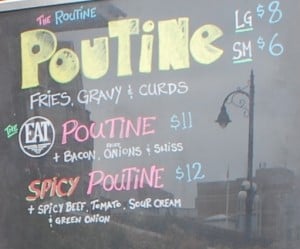 As you can see in the close- of the food cart menu board, their second specialty is . . . you guessed it . . . poutine. You can get “The Routine Poutine”, which is just plain old fries, gravy, and curds. Or you can fancy it up with the “Eat Poutine” version, topped with bacon bits, onions, and Swiss cheese. Or if you want to add a bit of extra flavor, get the “Spicy Poutine”, made with spicy beef, tomatoes, sour cream, and green onions. Alas, I’m still so focused on getting a daily fix of lángos that I haven’t tried a poutine. Someday . . .
As you can see in the close- of the food cart menu board, their second specialty is . . . you guessed it . . . poutine. You can get “The Routine Poutine”, which is just plain old fries, gravy, and curds. Or you can fancy it up with the “Eat Poutine” version, topped with bacon bits, onions, and Swiss cheese. Or if you want to add a bit of extra flavor, get the “Spicy Poutine”, made with spicy beef, tomatoes, sour cream, and green onions. Alas, I’m still so focused on getting a daily fix of lángos that I haven’t tried a poutine. Someday . . .
Throughout the weekend in Victoria, high winds just wouldn’t let up, with gale force winds sweeping the harbor. By Sunday night we were all tired of it, and looking forward to Monday when the forecast indicated we’d be back to light winds and warmer temperatures.
On Sunday evening over dinner at a local harbor restaurant, Kap, Andrea, and Steve exchanged weather reports and decided that an early Monday morning departure from Victoria would be best – between 6-7AM. Before heading north to our prawning grounds, the Couverden would return to Sidney for a couple of days, and Flying Colours would go directly to Delta Marine for fixes on any problems uncovered so far.
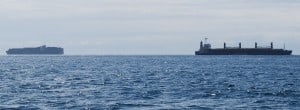 Monday morning at 6:30AM, we slipped the lines and departed Victoria’s Inner Harbour, and entered the Strait of Juan de Fuca – the main entrance to Washington State’s Puget Sound to the south, and British Columbia’s Vancouver area to the north. The seas in the Strait were pretty calm, the winds were still slight, and the rain showers in the area held off for us. We rounded the south end of Vancouver Island and turned north for Sidney, with only a couple of huge freighters off our starboard side (and we take great care to stay well away from the big boys – traveling at 25″ knots, even their wake is something you don’t want to trifle with).
Monday morning at 6:30AM, we slipped the lines and departed Victoria’s Inner Harbour, and entered the Strait of Juan de Fuca – the main entrance to Washington State’s Puget Sound to the south, and British Columbia’s Vancouver area to the north. The seas in the Strait were pretty calm, the winds were still slight, and the rain showers in the area held off for us. We rounded the south end of Vancouver Island and turned north for Sidney, with only a couple of huge freighters off our starboard side (and we take great care to stay well away from the big boys – traveling at 25″ knots, even their wake is something you don’t want to trifle with).
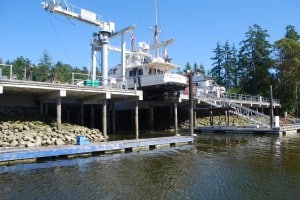
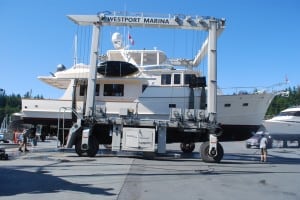 Once at Delta Marine, we were told the technicians would make quick work of our problems, but as with everything on a boat, reality just doesn’t happen that way. The first thought about our slow maximum speed problem (only getting 14 knots, instead of 16-18, and RPMs maxing out at 2,450 rather than 2650) was possibly due to diesel that had sat for 1½ years and “stuff” had grown in it. The fuel filters were examined and swapped out, then we took Flying Colours outside the harbor for a test spin – no improvement. The second thought was a dirty bottom, plus maybe dirty props and drive shafts – and that would mean a haul-out to pressure wash the bottom. The marina’s haul-out house was very busy, and the earliest they could slot us in was at 4PM the following day. So, nothing left to do but head for town to shop.
Once at Delta Marine, we were told the technicians would make quick work of our problems, but as with everything on a boat, reality just doesn’t happen that way. The first thought about our slow maximum speed problem (only getting 14 knots, instead of 16-18, and RPMs maxing out at 2,450 rather than 2650) was possibly due to diesel that had sat for 1½ years and “stuff” had grown in it. The fuel filters were examined and swapped out, then we took Flying Colours outside the harbor for a test spin – no improvement. The second thought was a dirty bottom, plus maybe dirty props and drive shafts – and that would mean a haul-out to pressure wash the bottom. The marina’s haul-out house was very busy, and the earliest they could slot us in was at 4PM the following day. So, nothing left to do but head for town to shop.
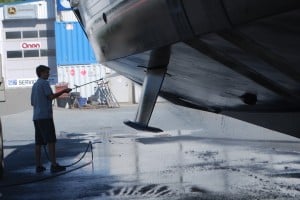 I always like to watch a haul-out. In the case of Flying Colours, it’s quite dramatic. She weighs 70,000 lbs – and to illustrate how much this is, the curb weight of a Toyota Camry is 3,263 lbs, so the all-up weight of Flying Colours is equal to more than 21 Toyota Camry’s! As the Travel Lift’s braided belts came taut beneath the hull of Flying Colours, I could hear the snap, crackle, and pop even from my photo vantage point about 25’ away. Once clear, the Travel-Lift moved forward about a boat length to a work area where the marina workers could get underneath with their pressure hoses. To our surprise, the bottom was a lot dirtier than we’d been led to believe by the scuba diver who examined it a week earlier. The props and rudder fins had dozens of barnacles encrusting them, and the overall bottom paint was coated with algae slime – no wonder we couldn’t get to maximum speed.
I always like to watch a haul-out. In the case of Flying Colours, it’s quite dramatic. She weighs 70,000 lbs – and to illustrate how much this is, the curb weight of a Toyota Camry is 3,263 lbs, so the all-up weight of Flying Colours is equal to more than 21 Toyota Camry’s! As the Travel Lift’s braided belts came taut beneath the hull of Flying Colours, I could hear the snap, crackle, and pop even from my photo vantage point about 25’ away. Once clear, the Travel-Lift moved forward about a boat length to a work area where the marina workers could get underneath with their pressure hoses. To our surprise, the bottom was a lot dirtier than we’d been led to believe by the scuba diver who examined it a week earlier. The props and rudder fins had dozens of barnacles encrusting them, and the overall bottom paint was coated with algae slime – no wonder we couldn’t get to maximum speed.
In the close-up photo of Flying Colours’ bottom, you can see the secret weapon that helps smooth out our ride in rough seas – the stabilizers. With one on each side of the hull, they act as airfoils to control the roll of the hull as it’s buffeted by waves. Gyro sensors in the engine room feed constant roll input to the computer-controller, which sends signals to move the fins like rudders, and in the blink of an eye they counteract a wave that would otherwise cause Flying Colours to rock and roll. Amazing gizmos (and pricey too)!
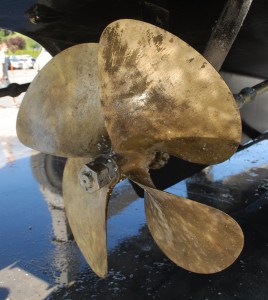 The top photo on the left shows what the props looked like as they were being pressure washed. Before they started on them, the props had a few dozen barnacles encrusting them – each about the size of a quarter, raised about ½”, and looked like little white towers of calcium shell that the little barnacle critters live in. We have a coating of “Prop Speed” applied to our props so that barnacles and crud doesn’t adhere to them, and for this to have occurred, it’s likely our diver who changes our zincs and cleans the bottom has cleaned the props too well, removing the Prop Speed as he did so. Shame on him.
The top photo on the left shows what the props looked like as they were being pressure washed. Before they started on them, the props had a few dozen barnacles encrusting them – each about the size of a quarter, raised about ½”, and looked like little white towers of calcium shell that the little barnacle critters live in. We have a coating of “Prop Speed” applied to our props so that barnacles and crud doesn’t adhere to them, and for this to have occurred, it’s likely our diver who changes our zincs and cleans the bottom has cleaned the props too well, removing the Prop Speed as he did so. Shame on him.
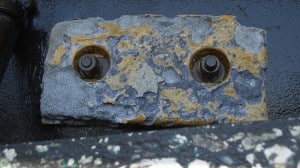 The second photo shows a large hull zinc – one of a dozen or so scattered around on various parts of the hull, wherever there is exposed metal – and gives a really good indication of how they’re “sacrificially” eaten by galvanic corrosion caused by stray electrical signals that are in the water, mostly in marinas where boats live that aren’t well grounded. The zincs are there to corrode away sooner than any other metal on the boat that’s in sea water, protecting it. We typically have our zincs replaced twice a year, by having a diver go under the boat at our marina slip, unbolting the old, corroded-away zincs and replacing them with brand new ones. The white splotches next to the zinc is the remains of barnacle shells, where the cement they use to adhere is really strong – so strong that you certainly can’t lift it off with your fingers.
The second photo shows a large hull zinc – one of a dozen or so scattered around on various parts of the hull, wherever there is exposed metal – and gives a really good indication of how they’re “sacrificially” eaten by galvanic corrosion caused by stray electrical signals that are in the water, mostly in marinas where boats live that aren’t well grounded. The zincs are there to corrode away sooner than any other metal on the boat that’s in sea water, protecting it. We typically have our zincs replaced twice a year, by having a diver go under the boat at our marina slip, unbolting the old, corroded-away zincs and replacing them with brand new ones. The white splotches next to the zinc is the remains of barnacle shells, where the cement they use to adhere is really strong – so strong that you certainly can’t lift it off with your fingers.
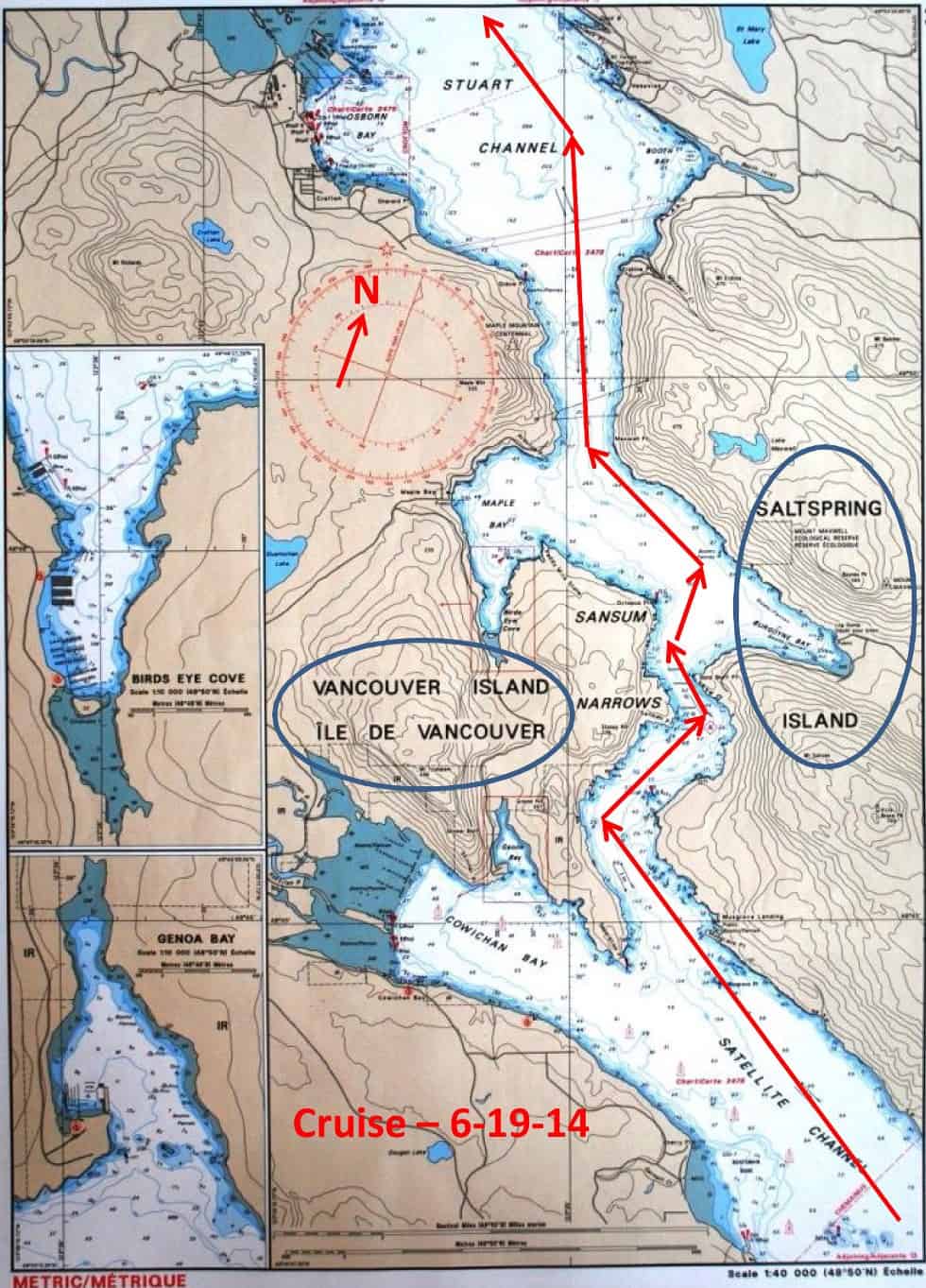 Finally . . . The Actual Cruise Begins. After three days at the Delta Marine dock, we were ready to head north with Flying Colours. At 6:45AM on Thursday (June 20), Kap motored us out of Tsehum Harbour, on a route that would take us across the Strait of Georgia, many miles north, and to the Seattle Yacht Club outstation at Garden Bay in Pender Harbour. It was a dicey call, as gale force winds and seas of 4’ and higher were forecast for the Strait, and that always makes us uncomfortable. We’d be following Andrea and Steve in Couverden, and the plan was to first head north from Sidney in very protected waters on the west side of Saltspring Island, in a curvy set of channels (shown on the chart at left).
Finally . . . The Actual Cruise Begins. After three days at the Delta Marine dock, we were ready to head north with Flying Colours. At 6:45AM on Thursday (June 20), Kap motored us out of Tsehum Harbour, on a route that would take us across the Strait of Georgia, many miles north, and to the Seattle Yacht Club outstation at Garden Bay in Pender Harbour. It was a dicey call, as gale force winds and seas of 4’ and higher were forecast for the Strait, and that always makes us uncomfortable. We’d be following Andrea and Steve in Couverden, and the plan was to first head north from Sidney in very protected waters on the west side of Saltspring Island, in a curvy set of channels (shown on the chart at left).
After exiting Stuart Channel at the top end of Salt Spring Island, we’d then wend our way on Trincomali Channel to the south end of Gabriola island. There’s a very narrow channel to cross, called Gabriola Pass, and the plan was to arrive at slack, and once through it we’d be out in the open water of the Strait of Georgia.
As we approached Gabriola Pass, Kap felt we’d missed slack time by too much, plus she was very concerned about the high seas and high winds on the other side. She made the decision to abort the plan, turn 180° and head to the tiny SYC outstation on Ovens Island for the night. When the weather cleared in the morning (assuming it would), we’d then head across the next day.
Steve and Andrea elected to continue on as planned, and within a couple of hours reported back that the weather and seas were fine, and they were having a very good and fast crossing of the Strait of Georgia.
Ovens Island. It’s officially called the Dunsmuir Islands (plural), as there are two of them, barely linked at high tide by some rocks that become exposed and you can hop across on them. A couple in the Seattle Yacht Club bought the northernmost island a few years ago, then gifted it to the SYC to be made into an outstation for cruising members. It’s a tiny island, barely 300’ long and 100’ across, with a 1,000’ long floating dock that the club constructed along the protected inside of the island, with a ramp to ashore.
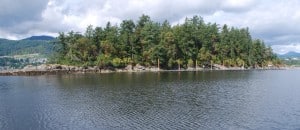 Of the 11 outstations the SYC owns between Gig Harbor (near Tacoma) and Desolation Sound (halfway up Vancouver Island), Ovens Island has always been one of our top 3 outstations – first because of its location halfway between Sidney and Nanaimo, and second because we’re the only ones there on many of our stops. This time was no different – empty when we arrived, empty overnight, and empty the next morning when we departed. The beauty of that is, we can take the dogs and cat ashore, even off leash (except for ZuZu), and we can easily make a circuit of the island in just a few minutes to get some exercise. There’s absolutely nothing on the island but trees, a couple of picnic tables and benches at either end . . . and solitude.
Of the 11 outstations the SYC owns between Gig Harbor (near Tacoma) and Desolation Sound (halfway up Vancouver Island), Ovens Island has always been one of our top 3 outstations – first because of its location halfway between Sidney and Nanaimo, and second because we’re the only ones there on many of our stops. This time was no different – empty when we arrived, empty overnight, and empty the next morning when we departed. The beauty of that is, we can take the dogs and cat ashore, even off leash (except for ZuZu), and we can easily make a circuit of the island in just a few minutes to get some exercise. There’s absolutely nothing on the island but trees, a couple of picnic tables and benches at either end . . . and solitude.
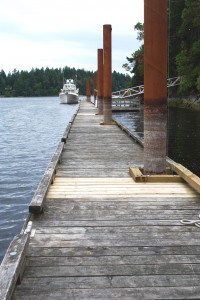 Our plan (well, Kap’s plan, as she had all of it in her head that she wanted to do . . . me, I was just along for the ride, and Gator couldn’t have cared less) was to get up super early the next morning (uhhhh, 3:30AM) to catch the slack at Dodd Narrows, push past Nanaimo and out into the Strait of Georgia, and continue on to the SYC outstation on Cortes Island (at the entrance to Desolation Sound) – a total cruising day of 88 miles. Actually, I thought it was overly ambitious, but . . . she’s the Captain. (Have I ever mentioned that I’m writing a book of our cruising experiences, to be titled “Captain, My Captain!”, with a subtitle of, “She’s Not Always Right, But She’s Always My Captain”.)
Our plan (well, Kap’s plan, as she had all of it in her head that she wanted to do . . . me, I was just along for the ride, and Gator couldn’t have cared less) was to get up super early the next morning (uhhhh, 3:30AM) to catch the slack at Dodd Narrows, push past Nanaimo and out into the Strait of Georgia, and continue on to the SYC outstation on Cortes Island (at the entrance to Desolation Sound) – a total cruising day of 88 miles. Actually, I thought it was overly ambitious, but . . . she’s the Captain. (Have I ever mentioned that I’m writing a book of our cruising experiences, to be titled “Captain, My Captain!”, with a subtitle of, “She’s Not Always Right, But She’s Always My Captain”.)
Overnight, it didn’t seem that Kap slept a wink. With the wind still blowing a gale, the rigging of the SYC burgee (flag) on the bow directly above our heads as we sleep in the V-berth was making one helluva racket as it clanged against the flag staff – and she got up as soon as we drifted off to sleep to corral it. Then Kap heard the main bilge pump kick on, and of course had to get up to check on that (to make sure we weren’t sinking at the dock). Then in the dead of night the “house bank battery” alarm went off, indicating our main batteries that power everything on the boat (except for engine starting) were at a critical stage of drain (there’s no shore power at Ovens Island, so you’re on boat battery power, similar to being at anchor) – and she found that the our WhisperGen diesel engine that’s supposed to keep the batteries charged had failed to fire up for some unknown reason, plus the breaker switch for the battery charger was tripped. Being up and down all night like a yo-yo was bad enough, but each time Kap couldn’t get back to sleep, she’d then spend the next hour beside me in bed with her iPad, checking the weather and trying to nod off. At 3:30 she was up for good, and tired as hell. Both of us were.
Making matters worse, it was still too dark at 4:30 to depart the dock. It was just becoming light, but not enough to see the crab or prawn pot buoys that litter the channel into Ovens Island. Worse, there are always logs to skirt around, and we knew we couldn’t be sure of seeing them. If we waited even 15 more minutes for better light, we’d be past the safe slack time at Dodd Narrows at 5AM. After discussing it at length, the decision was made to alter plans, wait until the 11AM slack at Gabriola Pass, head directly out into the Strait of Georgia, and head for the SYC outstation at Garden Bay. That now meant a 9:30 departure from Ovens Island, giving us several hours to just lounge around Flying Colours.
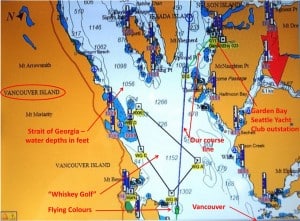 “Whiskey Golf is not active.” This was the best news of the morning, heard at 11AM on Environment Canada Marine VHF Channel 3 – indicating that the military test range just north of Nanaimo didn’t have any military maneuvers going on, and therefore, we are free to cross It. The test range is a sort of trapezoidal shaped area that’s about 8 miles long and 5 miles wide and covers 52 square miles. In the electronic chart screen shot at left, you can see Flying Colours (the little green boat-shaped object at bottom center), just about to enter Whiskey Golf.
“Whiskey Golf is not active.” This was the best news of the morning, heard at 11AM on Environment Canada Marine VHF Channel 3 – indicating that the military test range just north of Nanaimo didn’t have any military maneuvers going on, and therefore, we are free to cross It. The test range is a sort of trapezoidal shaped area that’s about 8 miles long and 5 miles wide and covers 52 square miles. In the electronic chart screen shot at left, you can see Flying Colours (the little green boat-shaped object at bottom center), just about to enter Whiskey Golf.
Whiskey Golf is a joint effort between the U.S. and Canadian Navies, and operated by Naval Undersea Warfare Center Division Keyport (NUWCDIVKPT). They (the Navy) don’t ever say much about it, but primarily the site is used for testing military warfare equipment, including torpedoes, sonar, and sonar buoys. Supposedly, 300-400 torpedoes are test-fired at the range each year, mostly from American Navy ships. The reason the area was chosen is the water depth, averaging around 1,300’ deep, the deepest part of the Strait of Georgia.
For boaters, the problem with Whiskey Golf is . . . its location. It’s smack dab in the middle of where we’d like to go, either cruising north from Nanaimo towards Desolation Sound, or crossing the Strait to get to the Sunshine Coast (on the Canadian mainland north of Vancouver). Luckily, they’ve created a ½ mile wide safe transit corridor along the western shore, and as long as you remain strictly within the confines of this, the Navy doesn’t give you any problem.
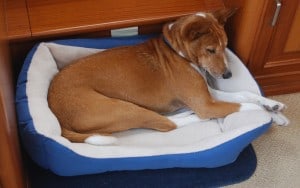 While the distance shown on the electronic chart above is only 3” or so (said with tongue firmly in cheek), our remaining time to go as we crossed the Strait of Georgia on our route to the Seattle Yacht Club outstation at Garden Bay was actually over 3 hours. At this point, and in a straight line across, the Strait of Georgia is 10-12 miles, and we’re crossing it at a pretty steep angle, so we have at least 30 miles to go (and if we had to go around the eastern tip of Whiskey Golf, or pass up the west side of it, the distance would add another hour to our journey. Unlike the day before, our crossing was with much lighter winds, and fairly mild seas (about 2’ chop). Having gotten up way too early this morning, we were both dog tired, so we traded off driving every hour or so, giving the other a chance to cat nap. Even Gator got several hours of good sleep . . . but then, that’s pretty much the norm for him.
While the distance shown on the electronic chart above is only 3” or so (said with tongue firmly in cheek), our remaining time to go as we crossed the Strait of Georgia on our route to the Seattle Yacht Club outstation at Garden Bay was actually over 3 hours. At this point, and in a straight line across, the Strait of Georgia is 10-12 miles, and we’re crossing it at a pretty steep angle, so we have at least 30 miles to go (and if we had to go around the eastern tip of Whiskey Golf, or pass up the west side of it, the distance would add another hour to our journey. Unlike the day before, our crossing was with much lighter winds, and fairly mild seas (about 2’ chop). Having gotten up way too early this morning, we were both dog tired, so we traded off driving every hour or so, giving the other a chance to cat nap. Even Gator got several hours of good sleep . . . but then, that’s pretty much the norm for him.
At 3:00PM, we arrived at Garden Bay, tired as hell – this is supposed to be a pleasure cruise for fun and relaxation, but sometimes it sure doesn’t feel like it.
